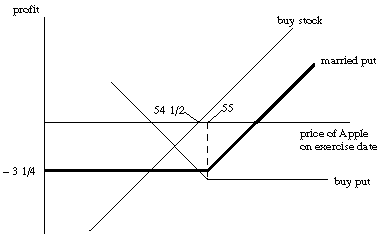Econ 156 Spring 1999 Second Test Answers
1. It is not true that, "Investments above the curve have too much risk." Investments above the curve are not possible, as the curve gives those portfolios that have the maximum expected return for any given level of risk.
2. Some of the buyers are institutions, not individuals, and may well be around 100 years from now. Either way, they can sell the bonds before maturity and, in any case, the present value of the principal 100 years from now is only a small part of the value of the bond. Two much more important concerns are the default risk for a BBB+ bond and the interest-rate risk for a bond with such a long duration.
3. The constant-growth dividend-discount model gives the equations

If we consider the shareholder required
return to equal the yield to maturity on best-grade corporate bonds plus
a risk premium, then

Therefore,

The -5.19% value for Stock/Bond Yield
Gap in August 1986 indicates that investors who required no risk premium
on stock would have had to anticipate a long-run dividend growth rate
of 5.19% to justify the current level of stock prices on intrinsic-value
grounds. Those who required, say, a 4% risk premium, would have had to
anticipate a 9.19% long-run dividend growth rate. If such growth rates
are implausibly high, then stocks appear to be overpriced by intrinsic-value
criteria.
4. One advantage of outside borrowing is that the tax-deductible interest creates a tax shield, reducing the firm's tax liability. A stock sales doesn't dilute shareholder equity unless the cash received from the sale is less than the value of the stock; the argument in the quotation ignores the fact that the cash raised from the sale can be used to buy more assets and generate more profits and dividends. It is true that there are tax reasons for paying less dividends and retaining more earnings rather than paying dividends and selling stock to raise cash.
5. For a 10-year $100,000 monthly amortized loan at 10% + 7% = 17%,
the monthly payments X are $1,737.98:
 The borrower only receives $100,000 - 7%($100,000) = $93,000
and $1,737.98 monthly payments on a $93,000 loan implies an effective annual
interest rate of 19.03%:
The borrower only receives $100,000 - 7%($100,000) = $93,000
and $1,737.98 monthly payments on a $93,000 loan implies an effective annual
interest rate of 19.03%:

With a 5-year loan, the initial 7% fees
become more burdensome, raising the effective interest rate (to 20.41%).
6. The profit of the stock depends on whether the price is above or
below 55. The put loses 3 3/4 unless the price of the stock is below the exercise
price of 55. Here is a graph:

A married put is a synthetic call. The purchase
of the put implicitly buys insurance against a decline in the price of the
stock. The investor here cannot lose more than 3 1/4, but the cost of this
insurance is the price of the put, in that if the stock's price rises, the
profit is 3 3/4 less than if no put has been purchased. The price must rise
to 54 1/2 + 3 3/4 = 58 1/4 for the investor to make a profit.
7. Tobin's q depends on firm profit rates relative to shareholders' required returns. When interest rates (and shareholder required returns) decrease, the value of Tobin's q should increase. If businesses judge expansion plans by seeing if the profit rate is larger than shareholders' required return (or, equivalently, seeing whether Tobin's q is greater than 1), then the drop in interest rates and rise in Tobin's q encouraged business investment. Such a stimulus could well be explained by the decline in interest rates, even if the economy and profit expectations are unchanged.
8. The return on a stock depends on how well the overall market does and on factors specific to this particular company; the stock's beta coefficient measures the extent to which its return moves with the return on all stocks. A low-beta stock is not very sensitive to overall market movements, but still may be very volatile--the standard deviation of its e may be very large. While beta is not a good measure of risk for an individual stock, it is a good gauge for a diversified portfolio, since the firm-specific risk (the es) will probably cancel each other out.
9. The stock exchanges are a secondary market. Unlike depositors withdrawing money from a bank, stockholders who sell their shares do not constitute a run on industries, because businesses are not obligated to redeem these shares.
10. No. Consider, for example, these two zeros: 100,000(1+x)25 = 500,000 and 100,000(1+y)25 = 1,000,000 implies x = 6.65% and y = 9.65%; however; 100,000(1+r)25 = 1,500,000 implies r = 11.44%, not 6.65 + 9.65 = 16.30%.

